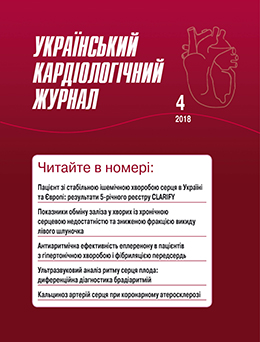Short- and long-term outcomes in patients after ST-elevation myocardial infarction with urgent percutaneous coronary intervention
Main Article Content
Abstract
The aim – to study clinical and functional characteristics of patients with ST-segment elevation myocardial infarction (STEMI), the terms of urgent percutaneous coronary intervention (PCI), the coronary artery lesions, gender and age, the parameters of intracardiac hemodynamics depending on the time to PCI; to assess the end-points at 1 year follow-up.
Material and methods. Between Feb till May 2015 we conducted a single-center prospective study and enrolled 108 patients with STEMI that underwent PCI (coronary angiography with stenting). We analyzed the terms of PCI after acute coronary syndrome symptoms onset, demographic, anamnestic, clinical, echocardiographic, angiographic data, as well as characteristics of interventions. We studied end-points, such as death, recurrent non-fatal MI, unstable angina, at 12 months follow-up after STEMI. Data on clinical outcomes were available in 100 of 108 patients (92.6 %).
Results. According to the study results, half of STEMI patients underwent PCI within 3.5 hours; only 20.4 %
patients – within the optimal time window (up to 2 hours); 60 % of patients – from 2 to 6 hours. Only 47 % of patients underwent complete revascularization. However, stenotic lesions ≥ 70 % were identified in 40 % of patients. Severe coronary lesions, suitable for CABG, were detected in 14 % of cases. Large LV aneurysm with intramural thrombus formation was diagnosed in 4 % of patients. Females, compared to males, were older, with the more prevalent concomitant hypertension and diabetes mellitus. Only 33 % of patients were judged as low-risk patients, according to the PAMI-II criteria. At 1 year follow-up, 3 % patients died from recurrent MI. These patients had single- or two-vessel disease, with stenting of the culprit artery. Among patients suitable for CABG, surgical revascularization was performed only in 1/3 cases.
Conclusions. The registry data allow to assess the profile of STEMI patients undergoing PCI, as well as short-term (at discharge) and long-term (at 1 year follow-up) outcomes.

